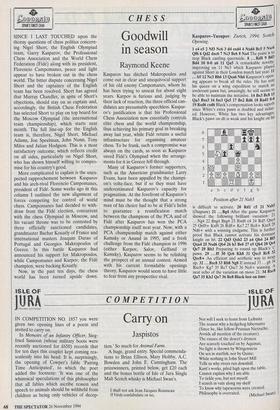DD' roc•eavi QM
SPAIN'S FINEST CAVA SPAIN'S FINEST CAVA
•
Dati41153
CHESS
Goodwill in season
Raymond Keene
SINCE I LAST TOUCHED upon the thorny questions of chess politics concern- ing Nigel Short, the English Olympiad team, Garry Kasparov, the Professional Chess Association and the World Chess Federation (Fide) along with its president, Florencio Campomanes, peace and light appear to have broken out in the chess world. The bitter dispute concerning Nigel Short and the captaincy of the English team has been resolved. Short has agreed that Murray Chandler, in spite of Short's objections, should stay on as captain and, accordingly, the British Chess Federation has selected Short to play on top board for the Moscow Olympiad (the international team championship), which starts next month. The full line-up for the English team is, therefore, Nigel Short, Michael Adams, Jon Speelman, John Nunn, Tony Miles and Julian Hodgson. This is a most satisfactory outcome, which reflects credit on all sides, particularly on Nigel Short, who has shown himself willing to compro- mise for his country's good.
More complicated to explain is the unex- pected rapprochement between Kasparov and his arch-rival Florencio Campomanes, president of Fide. Some weeks ago in this column I outlined the new alignment of forces competing for control of world chess. Campomanes had decided to with- draw from the Fide election, concurrent with the chess Olympiad in Moscow, and his vacant throne was to be contested by three officially sanctioned candidates, grandmaster Bachar Kouatly of France and international masters Joaquin Durao of Portugal and Georgios Makropoulos of Greece. In this battle Kasparov had announced his support for Makropoulos, while Campomanes and Karpov, the Fide champion, were backing Kouatly.
Now, in the past ten days, the chess world has been turned upside down. Kasparov has ditched Makropoulos and come out in clear and unequivocal support of his old enemy Campomanes, whom he has been trying to unseat for about eight years. Karpov is furious and, judging by their lack of reaction, the three official can- didates are presumably speechless. Kaspar- ov's justification is that his Professional Chess Association now essentially controls elite chess and the world championship, thus achieving his primary goal in breaking away last year, while Fide retains a useful infrastructure for organising amateur chess. To be frank, such a compromise was always on the cards, as soon as Kasparov saved Fide's Olympiad when the arrange- ments for it in Greece fell through.
Many of Kasparov's former supporters, such as the American grandmaster Larry Evans, have been appalled by the champi- on's volte-face, but if so they must have underestimated Kasparov's capacity for pragmatism. At the forefront of Kasparov's mind must be the thought that a strong man of his choice had to be at Fide's helm to guarantee a reunification match between the champions of the PCA and of Fide after Kasparov has won the PCA championship itself next year. Now, with a PCA championship match against either Kamsky or Anand in 1995, and a fresh challenge from the Fide champion in 1996 (either Karpov, Salov, Gelfand or Kamsky), Kasparov seems to be relishing the prospect of an annual contest. Armed with his current formidable openings theory, Kasparov would seem to have little to fear from any prospective rival. Kasparov—Yusupov: Zurich, 1994; Scotch Opening.
e4 e5 2 Nf3 Nc6 3 d4 exd4 4 Nxd4 Bc5 5 Nic6 Qf6 6 Qd2 dxc6 7 Nc3 Be6 8 Na4 The point is to stop Black castling queenside. 8 ...Rd8 9 Bd3 Bd4 10 0-0 a6 11 Qa5 A remarkable novelty, improving on 11 Nc3 which Kasparov played against Short in their London match last year. 11 ...b5 12 Nc3 Bb6 13 Qxa6 Nh6 Kasparov's open- ing appears to break all the rules. He has sent his queen on a wing expedition to snatch an irrelevant pawn but, amazingly, he still seems to be able to maintain the initiative. 14 Be3 8e8 15 Qa3 Bxe3 16 fxe3 Qe5 17 Be2 Rd6 18 Radl 0.0 19 Rxd6 cxd6 Black's compensation looks superb since White's extra pawn is doubled and isolat- ed. However, White has two key advantages. Black's pawn on d6 is weak and his knight on h6 is difficult to activate. 20 Rdl c5 21 Nxb5 (Diagram) 21 ...Bg4 After the game Kasparov showed the following brilliant variation: 21 Ng4 22 Bxg4 Bxg4 23 Rxd6 c4 24 Rc15 Qxe4 25 Qxf8+ Kxf8 26 Rd8+ Ke7 27 Re8+ Kxe8 28 Nd6+ with a winning endgame. This is further proof that Black cannot activate his dormant knight on h6. 22 Qd3 Qxb2 23 a4 Qb4 24 1113 Qxa4 25 Nxd6 Qb4 26 h3 Be6 27 e5 Qh4 28 Qe1 Qe7 29 Rbl Preparing to round up Black's `C pawn. 29 ... f5 30 Qc6 Kh8 31 QxcS RcS 32 QxcS+ An efficient and aesthetic way to wrap up. 32 ... Bxc8 33 Rb8 Ng8 If instead 33 ...g6 34 Rxc8+ Kg7 35 Rc7 Qxc7 36 Ne8+ winning. A neat echo of the variation on move 21. 34 ftxc8 Qa7 35 Kh2 Qe7 36 Re8 Black lost on time.










































































 Previous page
Previous page